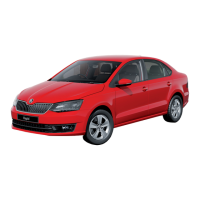Check and refill
Fig. 79
Dipstick variants
Read and observe and on page 77 first.
Check and refill oil under the following conditions.
The vehicle is standing on a horizontal surface.
The engine operating temperature is reached.
The engine is switched off.
Checking the level
›
Wait a few minutes until the engine oil flows back into the oil trough.
›
Pull the dipstick out and wipe with a clean cloth.
›
Push the dipstick back to the stop and then pull it out again.
›
Read the oil level and push the dipstick back in.
The oil level must be in range
A
» fig. 79. If the oil level is below range
A
, oil
must be added.
Refilling
›
Unscrew the cap of the engine oil filler opening
D
» fig. 77 on page 76.
›
Replenish the oil in portions of 0.5 litres in accordance with the correct spec-
ifications » page 77.
›
Check the oil level.
›
Screw the lid of the engine oil filler closed carefully.
CAUTION
■
The oil level must never be below range
A
» fig. 79 – There is a risk of dam-
age to the engine as well as to the exhaust system.
■
If a top up with oil is not possible or the oil level is above range
A
, Stop
driving! Switch off the engine and seek assistance from a specialist garage.
Notice
If the engine oil level is too low, a warning light lights up in the instrument clus-
ter » page 24, Engine oil. Nevertheless, we recommend checking
the oil level on a regular basis using the dipstick.
Coolant
Introduction
The coolant helps to keep the engine temperature down, and consists of water
and coolant additive (with additives that protect the cooling system against
corrosion and prevent furring).
The proportion of coolant additive in the coolant must be 40 to 60 %.
The correct mix of water and coolant additive should be checked and if neces-
sary corrected by a specialist garage.
WARNING
■
The following instructions must be followed at all times when working on
the engine compartment » page 75.
■
Never open the end cover of the coolant expansion reservoir while the
engine is still warm. The cooling system is pressurised - There is a risk of
scalding or injury from splashes of coolant!
■
To protect against the coolant splashing, cover the cap with a cloth when
opening.
■
Coolant and coolant fumes are harmful - avoid contact with the coolant.
If the coolant comes into contact with the eye or skin, wash the affected
area with plenty of water for several minutes, and where appropriate seek
medical help.
CAUTION
Do not cover the radiator and install any parts (e.g auxiliary lights) in front of
the air intakes - There is a risk of the engine overheating.
78
General Maintenance

